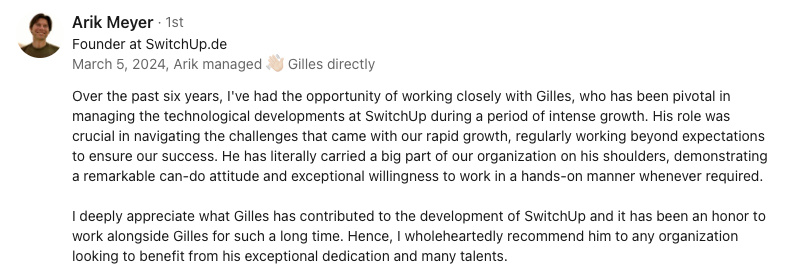Abstract:
The article addresses the growing challenge indie tech professionals face in separating work from personal life now that traditional office cues—like commuting, coworker chatter, or set schedules—have disappeared. It explains how the lack of clear boundaries leads to “work creep,” where late-night emails, weekend calls, and constant connectivity cause stress, fatigue, and declining job satisfaction. Drawing from personal experience and research, the article highlights the health risks of always being “on,” including poor sleep and emotional burnout, and emphasizes the importance of creating simple, personalized rituals—such as shutting a laptop, changing clothes, playing music, or sharing an end-of-day emoji with an online group—to signal the end of the workday and support well-being. Practical advice is offered for experimenting with minimalist routines, adapting boundaries as life changes, and using community or digital habits to foster closure and connection. The overarching message is that maintaining sustainable independence in tech work relies on flexible, self-compassionate boundary-setting, where even small, evolving habits can restore balance and make freelance life healthier and more enjoyable.
Once, it was simple to know when work finished and life began. The packed metro, a quick coffee, and the buzz of coworkers helped mark the borders. For indie tech professionals now, those clues have faded. Work can sneak in anywhere. Late-night emails, weekend calls while out walking—it all blends together. This article explores why work and life mix so easily for indie tech workers and why it really matters for well-being.
You’ll find practical ideas for spotting 'work creep,' understanding the true cost of mixed boundaries, and picking up easy, minimalist routines that help show when the workday ends. There’s a look at how traditional offices made nice, clear buffers, what happens to health when you’re always 'on,' and ways indie pros use personal habits—like closing laptops or putting on music—to make a real difference. There’s also a bit about how sharing rituals in online groups can add some closure and friendly vibes.
Whether you’re starting out or overwhelmed by never-ending tasks, this guide offers tools and ideas to build healthy boundaries and make indie tech work more sustainable—and maybe a bit more fun.
Why work and life merge for indie tech professionals
Office routines once drew the line
Before, starting work meant the metro, coffee, and a desk. The office came with handy signals: the sound of people gathering, the regular break for lunch, and even the flickering lights at closing time. These routines, though sometimes boring, made it easy to know when work stopped and home began. Some theories say these social and physical cues are vital—they give your mind permission to switch off, helping avoid stress and confusion. When these are gone, the split between work and home slowly disappears, and people are left without a good 'off switch.'
When structure disappears, work seeps in
Without the built-in rules of an office, freelance and remote tech work often turns into an endless list. Suddenly it’s normal to reply to emails at midnight or pick up calls halfway through a Sunday hike—sometimes not even noticing how much work has crept into personal moments. This is what many call 'work creep.' I remember once settling in for a movie night in Lisbon, only to get a Slack ping from a Berlin client that “couldn’t wait.” That’s the kind of thing that chips away at your downtime. Surveys show a lot of freelance and remote tech workers struggle to unplug, working odd hours or even on holidays. Without those outside cues, work quietly fills up every bit of free space, making it hard to truly stop.
The hidden costs of always being 'on'
This mix of work and life isn’t just about busier days—it really affects health. Many indie tech people find themselves answering late emails, skipping breaks, and checking notifications all the time. Over time, blurry lines lead to tiredness, long-term stress, and always feeling behind. I’ve seen it firsthand: when I started tracking my time in Berlin, I realized I was working nearly 20% more hours than I thought—most of it bleeding into evenings and weekends. That creeping overtime didn’t just make me tired; it slowly drained my motivation. Studies show that when work spills into personal time, stress goes up and job joy goes down. In my own case, the data was a wake-up call—without clear boundaries, even the most exciting projects start to feel heavy, and burnout sneaks up before you know it.
The cost of lost boundaries
Stress and emotional fatigue build up
When work is just a click away, the mind doesn’t get proper rest. Always being reachable and having no clear border slowly builds up stress, leading to emotional burnout and a feeling of never being 'off.' Over time, this can feel like constant tiredness, grumpiness, or even a bit of dread when opening the laptop. Some research shows that blurred boundaries are linked to ongoing stress and tiredness, making it tough to really feel recharged.
Health risks rise as boundaries fade
It’s not just about mood. When I was living in Beijing, I noticed my sleep got worse and my shoulders were always tense—classic signs of too much work bleeding into life. Poor sleep, more heart problems, and higher rates of worry or sadness are all more common when work and life mix—especially in tech jobs where the mind is always running. Common signs include:
- Trouble falling or staying asleep
- Headaches and muscle tension
- Feeling anxious or low for days
On top of health, these blurry borders can zap motivation and enjoyment from independent work.
Motivation and satisfaction slowly drain away
Week after week, losing boundaries can make tech work less satisfying. The freedom that once felt exciting now turns into pressure and shrinking motivation. Keeping independent work going needs healthy borders—otherwise, the very freedom that was appealing starts to feel heavy. Knowing how boundary rituals work is one big help for building better habits.
Understanding boundary signals in indie tech work
What boundary signals are and how they help
Boundary signals are little cues—maybe physical, time-based, or mental—that mark the switch between work and home. They fill the hole left by office routines. It could be something as simple as shutting the laptop or taking a short walk before relaxing. These routines are simple in idea but powerful in effect, letting the mind know it’s time to shift gears.
And do these little tricks work? Even tiny habits—changing shirts, adjusting the lights, or putting on a certain playlist—send strong boundary signals, even in tiny shared flats. Some like lighting a candle to show the end of the day or using a special mug only for work. The best habits are simple, personal, and regular.
People who use strong boundary signals at home say they have less mix-up between work and family roles and feel better overall. These tricks help shrink stress and make it easier to really unplug from work. Looking at old office routines gives some clues about why these signals help so much.
How office routines set boundaries
Office routines—like traveling to work, scheduled breaks, and small team traditions—helped people mentally shift between work and home. The commute gave a buffer to prepare or unwind. Lunch with colleagues and little social rituals made it easy to step away from the desk. These cues also helped build a sense of team and brought predictability to each day.
These routines did more than tell time—they made it easier to change roles through the day and kept stress down. Now, indie workers have to come up with their own borders.
If you’re working indie, it’s your job to find and shape small, personalized rituals that fit your own setup. Next, we’ll look at ideas for practical, minimalist habits you can use, even if you work from your kitchen table.
Simple rituals for boundaries
Small rituals that mark the end of work
Even very small changes to your environment can help draw a line between work and life. Simple habits—like closing your laptop, putting on comfy clothes, or lighting a candle—act as repeated markers that work is truly done. For example, closing the laptop at the same time every night, or swapping a work shirt for a hoodie after the last meeting, both create a clear mental break, even in small apartments.
Environmental cues for mental separation
Tweaking your workspace can also help you switch modes. Moving from a chair to the sofa, dimming the lights, or cracking open a window all send the message it’s time to relax. No need for a home office—just a bit of creativity. For some, it could be sitting in a new spot for dinner to mark the end of work.
Using music and sound as transition tools
Music and sound can really play a part. Many tech indie folks tie a special playlist to the end of the working day—hitting play on a favorite song signals the day is done. Maybe it’s a 'work’s over' tune or a podcast only for evenings. It’s a fun trick and helps the mind switch off.
Physical gestures that anchor transitions
Physical actions are just as helpful. Closing a notebook, turning off a desk lamp, or putting away that work-only mug are all simple, steady signs to the brain that it’s time for a break. Even stacking up your papers can make a difference. These steps become easy to repeat and reliable for rest.
Personalizing rituals for indie life
Everyone likes their own version. Many solo workers try out unique cues—maybe starting the day with a hoodie or ending with a candle or a quick emoji to a friend. These personal touches make the boundary stick, even when schedules change.
Digital rituals and community connections
Some like digital habits, like updating a status or sending a group meme. These online routines add a friendly end to the day and give a soft sense of community. For example, sharing a checkered flag emoji in a chat at the end of the day.
Letting rituals evolve with your life
Micro-rituals don’t stay the same forever. They change as living spaces, seasons, or moods shift. Maybe you swap a candle in winter for a walk in spring, or use an online sign-off during busier weeks. This flexibility makes boundaries last and real, no matter what. These signals aren’t just for squeezing out a little more work—they’re needed to protect well-being and support a life in indie tech.
Boundary signals support well-being
Emotional decompression and recovery
Clear routines at the end of the workday don’t just tell you to stop—they help your brain unwind. Like finishing a tough sprint, closing the laptop and moving into a new space signals a break. These mini closures are calming and help recovery, which is key for feeling good and ready for tomorrow. Using these signals every day is connected to lower stress and less burnout. Small habits—like shutting tech off or changing rooms—can boost both mood and energy for the next morning. These boundaries also help you be more present with friends or family, adding a lift to your social life as well.
Healthy lines between work and home keep the independent lifestyle sustainable. Protecting your time and relationships helps keep motivation up, even when the job gets tough.
Sustainable independence
Without good boundaries, the freedom of indie tech life can quickly grow overwhelming. The urge to always be on and keep answering leads to tiredness and less joy. Easy-to-use, minimalist signals—maybe your favorite playlist or a quick status update—help keep autonomy alive while avoiding burnout. They guard your energy for both work and the things you love.
I learned this the hard way. There was a week in Lisbon when I missed three family dinners in a row because I kept answering “just one more” email after hours. My partner finally called me out, and I realized I needed a ritual to mark the end of my day. Now, I make a point to close my laptop, put on my sneakers, and walk through the park at sunset. That simple act—moving my body, breathing the evening air—signals to my brain that work is done. It’s not perfect, but it’s made a world of difference for my mood and my relationships.
Next up is working out which signals fit best in your own day so strong boundaries hold up through any change.
Experiment with boundaries
The Three Cues: A minimalist framework
Starting small with boundaries takes the pressure off. Good boundary signals are different for everyone; what works for one might not click for another. Over the years, I’ve found it helps to experiment with what I call The Three Cues:
- Behavioral cues: Actions like changing clothes, packing up tools, or closing your laptop.
- Time-based cues: Setting clear working hours or using alarms to mark the end of the day.
- Environmental cues: Adjusting your space—switching seats, changing lighting, or using a special mug.
Try mixing and matching these cues. For example, after a long day leading a multicultural team in Beijing, I’d switch off my desk lamp, put on a playlist from home, and send a quick “good night” emoji to my team chat. That combo helped me step out of work mode, even when my apartment doubled as my office.
Tracking your time can also reveal patterns of work creep. I started logging my hours in Berlin and was shocked to see how often I worked past my set stop time. That data helped me spot trouble early and tweak my rituals before burnout set in.
Self-compassion and ongoing adjustment
It’s normal for signals to wear off or need a tweak as your routine changes. Self-kindness lets indie pros refresh boundaries without piles of guilt. Life brings new jobs or different living setups—the border signal might just need an update.
Checking in with yourself helps spot problems early. Ask simple questions: 'Have I felt rested after work this week?' 'Is it tough to switch off?'—and adjust before things pile up. This kind of honest look keeps boundaries working.
Letting roommates or teammates know your end-of-work ritual can make signals even stronger. Whether solo or in a team, a bit of talking helps keep those lines sharp.
Micro-community rituals for closure
Digital rituals that reinforce boundaries
Joining in digital co-working or remote group rituals builds some soft social pressure to respect boundaries. Just waving in a chat at the start and end of a work session helps everyone respect work hours.
Team-wide calendars and simple shared habits help too. Maybe a team blocks out 'quiet hours,' or everyone shares a small result before logging off on Fridays. These tiny communities make it easier to hold boundaries and end the day with a smile—even when working alone.
The well-being boost of micro-community
Shared end-of-day signals do more than hold the line—they add a little sense of belonging. Even a quick emoji or a friendly sign-off at the end of the day can break up the loneliness of solo work and make people feel supported.
It doesn’t need to be deep. A check-in or playful meme each day can let indie tech folks feel like they’re part of something. But sometimes, boundaries fall apart and need a new approach, especially when things start to slip or old worries come back.
Troubleshooting and evolving boundaries
Spotting early signs of boundary erosion
Even the best routines can weaken. Signs that boundaries are slipping: too much late work, saying yes too much, or not being able to unplug. Warning signals:
- Working outside set hours more than a couple times each week
- Feeling you have to respond to every message, even weekends
- Finding it hard to say no, even when already tired
Physical and mood symptoms matter too. Headaches, never-ending tiredness, or even resentment and anxiety can all mean boundaries are fading. Seeing these early gives you the chance to fix things before stress builds up.
Resetting and adapting your signals
First, stop and take an honest look. Simple self-checks—like asking yourself, 'Does my routine leave me wiped out?'—help spot the weak spots. Small changes, such as shifting working hours or trying new rituals, keep adjustments manageable, not overwhelming.
Let family, roommates, or clients know about new plans if it helps. Repeating new routines regularly—like logging off at a set time or trying a new end-of-day song—will help them stick. Sometimes, a little support from someone else makes the change smoother.
Expect it to be a bit tough—old habits will try to sneak back, and not everyone will get on board right away. Add good things—like a short walk or five minutes quiet after stopping work—to help support the change and look after your well-being.
From years of working in different countries and shifting between fast-paced tech roles and slower ones, I’ve learned that healthy boundaries need regular readjusting—they’re not a one-time project. They shift and change along with life and work. Being flexible and gentle with yourself keeps them strong.
Mixing work and personal life is a real challenge for indie tech professionals. The old clues—like commutes or office noise—are gone, but simple habits can stand in and restore a sense of closure after work. For me, moving from Berlin’s relentless pace to Lisbon’s slower afternoons forced me to rethink my boundaries. Now, a sunset walk or a shared meme with my team does more for my well-being than any fancy productivity hack. The trick is to keep experimenting, stay honest with yourself, and remember that even the smallest ritual—a song, a mug, a message—can make a surprising difference.














